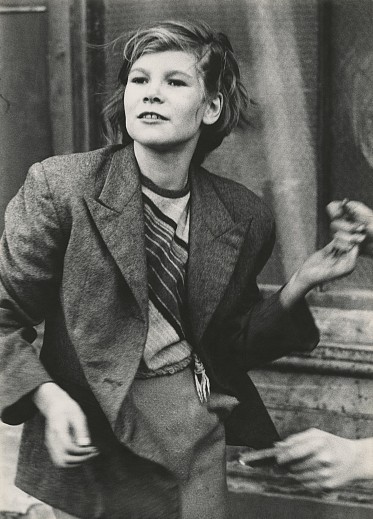
Roger Mayne in COLLECTOR DAILY
March 10, 2023 - Loring Knoblauch
What he saved for his family
As an artist nears the end of his or her life, in addition to working through the inevitable questions of how the estate will be managed in the future, it is often the case that the artist sets aside works for family, friends, and loved ones, so that they don’t get overlooked, inadvertently sold off, or lost in the shuffle. And in the years before he died in 2014, the British photographer Roger Mayne did just this, working with gallerist Tom Gitterman to box up a selection of the last vintage prints from some of his favorite and most noted images from the 1950s, which became known as “Ann’s Box” (for his wife Ann Jellicoe and their family). This tightly-edited show is made up of works from that personal cache, the prints having now drifted down the generations.
Mayne's enduring legacy lies as a concerned social documentary photographer, who took some of Henri Cartier-Bresson's ideas about the immediacy of photojournalism and applied them to the hardships visible in the streets of post-war Britain. It is his photographs from 1950s London that are most deservedly famous, particularly those of energetic children playing in the streets and fashionable Teddy Boys parading on the sidewalks. The best of Mayne's pictures capture a contagious youthful resilience in the face of austerity and decay, where the joys of community life can be found in bustling street games and slicked back pompadour haircuts.
As seen here, Mayne’s contrasty prints make the most of extremes of light and dark, especially when surrounded by middle grey drabness. Several of the images here come from Southam Street, and feature roving packs of children that the photographer has stacked into layered compositions. In one dramatic scene, a young girl screams in the foreground, while a stiff legged boy walks nearby and a pair of kids tries to do a headstand off the stairs in the background, each component of the moment seemingly independent of the others. And in another street corner group, a pair of young boys in shorts anchors the right side, while several girls, one in a buttoned-up cardigan, watch them, with a striding suited man in the background, the scene again smartly assembled from seemingly disparate parts.
Children were a consistent favorite for Mayne, and a number of other images he saved for his family make kids the central subject. One group of boisterous boys enjoys the antics of a central figure with exuberantly outstretched arms, the rest of the crowd hooting and hollering with obvious enjoyment. A pair of images of boys playing soccer in the street captures the action with energetic stop motion intensity, with one classic view featuring a young goalie reaching for a ball just out of his reach as he leaps to make the save. And a quiet portrait of a young girl sitting on some concrete stairs balances all that visual dynamism with a more subdued sense of grace, her timid glance straight into the camera and hunched pose capturing a hint of the haunted anxiousness that filled those days.
Mayne was also one of the first photographers to document the fashions of Britain’s teenagers, particularly the Teddy Boys and Girls who in the face of austerity turned to the more Edwardian styles of long drape coats with velvet lapels, skinny ties, narrow pants, and chunky brogues. Mayne’s images capture the Boys hanging around in groups or making a scene on the streets, the contrasts of his prints well matched to the crispness of their looks. And one image of a few Teddy Girls finds them posing with similar verve, their high necked blouses and long blazers giving them a cheeky style that stood out from the crowd. In still other images of teenagers, Mayne told stories of growing up and testing limits, from one group of girls gambling on the sidewalk to another girl jiving with a slinky sense of cool. The only image of adults in this small show looks down a busy street in the City of London, where men in dark suits walk along the crowded street; nearly all of them carry an umbrella or a cane, adding another set of insistent verticals to the composition.
For those interested in building or strengthening a collection of mid 20th century British photography, rarities like these are becoming increasingly scarce, and it’s difficult to think of a more resonant provenance than prints saved by the artist for his own family. While this show only quickly skims across Mayne’s career, the lively energy and compassion of his photographic eye is consistently apparent. During a time of deprivation, Mayne found small glimpses of hope and optimism in the eyes of the youth, who were determined to make lives for themselves regardless of the circumstances.
Back to News
